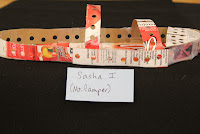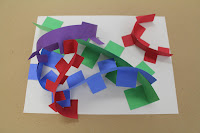Tie-Dye Camp T-Shirts
*Jacquard dyes & kit, squeeze bottles, white t-shirts, lots of rubberbands (I like the thicker ones), gloves (note: check for latex allergies, can use Nitrile gloves instead), water source: hose or sink, gallon ziploc bags for wet shirts
Laura is the tie-dye shirt expert! Stephanie's tips are: for the most vibrant colors, prewash shirts and read manufacturer's instructions. Show the designs that can be created using the handout (spirals, circles, etc.). Help younger kids with the rubberbands, you want them really tight since it's a resist technique. The rubberbands keep the dye off the shirt. Review how colors mix (color wheel is helpful). Red & Yellow=Orange, Blue & Yellow=Green, Blue & Red=Purple. If not cutting rubberbands off the shirts and rinsing them at camp, then send shirts home in sealed ziploc bags with child's name on bag and rinsing/washing directions attached.
Have fun!!!
*magazines (any kind but National Geographics are great for backgrounds), 9x12 & 12x18 white paper, glue, scissors, 1 gallon ziploc bag per child (to save cut images while in process).
View "Get Surreal" video and Dragon in my Art Room Blog (Dali lessons). ~OR~ show students "The Persistence of Memory" by Salvador Dali. Asks students what they see in it, what they like and what's interesting. Surreal art is dreamlike yet realistically rendered. Students need to use at least one element of surrealism in their collage: dislocation (putting something in an unusual location), juxtaposition (placing 2 objects near each other that are not normally found together), metamorphosis (changing one object into another object), and symbolism (an object resprenting an idea). Students need to find a large background image and also cut smaller images to juxtapose, dislocate, etc. Careful cutting is a must. Students are asked to discard inappropriate magazine images (violent images, alcohol, too much skin, etc.). The more strange and unusual the better!
da Vinci sketchbooks, backwards writing
*pencil, paper, imagination!
Inspiration: Discuss the life of Leonardo da Vinci (1452-1519, Italian). da Vinci was a painter (Mona Lisa), sculptor, inventor, architect, engineer...a true Renaissance man. Above is his sketch for a spinning wheel from his sketchbooks. da Vinci cryptically wrote backwards in his sketchbooks and filled them with sketches from nature, anatomy and inventions. See more inventions at da-vinci-biography.com.
Activity: Students will create an invention and label the parts. For a challenge they can try writing backwards. Test the writing by viewing it in a mirror.








.JPG)
.JPG)
.JPG)
.JPG)






































.JPG)









